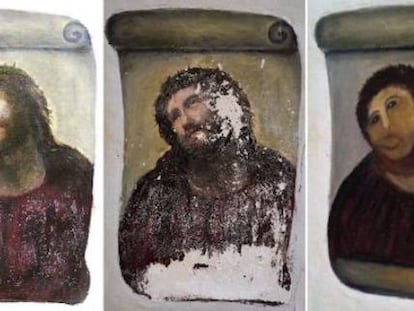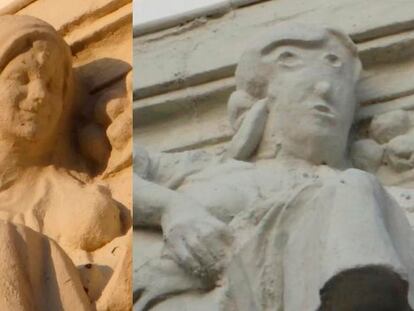Mystery ‘restorer’ patches up 13th-century church in Spain with cement
Residents of the village of Castronuño say they don’t know who did the botched job, but warn the building has significant structural damage that requires urgent action
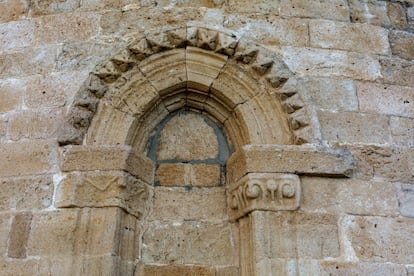

The church of Santa María del Castillo has been sitting at the highest point of the small village of Castronuño, in Spain’s northwestern Valladolid province, since the 13th century. But it was only recently that one of its 860 residents noticed something oddly out of place on one of its ancient stone walls: modern grey cement.
An unknown individual had taken it upon himself to “restore” a historical structure built in the Romanesque architectural style and listed as an Asset of Cultural Interest (BIC in its Spanish acronym) by the regional government of Castilla y León.
The unauthorized work has damaged the artistic value of the temple and left two questions lingering in the air: who did it, and above all, when? Some locals believe the amateur restoration must have taken place recently, while others suspect it was probably done some time ago but was only noticed now. Some experts, however, think it unlikely that in such a small village, nobody knows who put the cement there.
Villagers are also accusing the regional government of failing to act in time to make the structural improvements that the building clearly needs. The last time any restoration of note was carried out was 60 years ago, say local authorities.
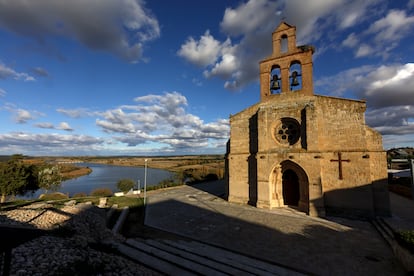
A stroll around the walls of the church’s side aisles offers sweeping views of the Douro River (or Río Duero in Spanish) as it crosses the vast moorlands of Castilla. Mayor Enrique Seoane points up at a small window located around four meters above ground level, where the cement job is clearly visible. He notes that the unknown worker must have used a ladder and a bucket to do the deed without being seen. While critical of this impromptu restoration, Seoane underscores that there are large cracks in the church walls where weeds are growing unchecked, and that the roof also needs repairs. “The cement thing is just anecdotal,” he says.
The mayor adds that the building’s BIC status, which should theoretically provide increased protection and conservation, is in fact a hurdle against efforts by local and provincial authorities to pay for improvements. “Nothing can be done without being greenlighted first by the Archbishopric and the Heritage agency, and no money has been forthcoming,” he says. The regional government is currently restoring some altarpieces, but Seoane notes that without fixing the structural damage to the building, this will be of little use. He says that the last restoration work took place 60 years ago, and is afraid that by the time anything new gets done, it might be “too late.”
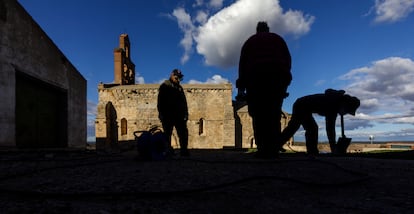
Javier Castán, who teaches art history at Valladolid University and has written extensively on the church, formerly known as the Church of Saint John the Baptist, is skeptical about the fact that nobody seems to know who did it. “It’s hard to believe that in a place with 800 residents, nobody saw the individual or individuals who acted in such a shoddy, irresponsible way, unless we are dealing with another case like the Ecce Homo of Borja [a widely reported botched restoration of a Christ figure in 2012],” he notes.
This expert underscores the high value of the church, which epitomizes the late Romanesque style of Castilla y León and additionally contains the funerary chapel of Fernán Rodríguez de Valbuena, who was a prior of the military order of Hospitallers of St. John of Jerusalem, better known as the Knights of Malta, and a crucial historical figure under the reign of Alfonso XI of Castile.
Over at the local bar, El Descanso, nobody seems to know who was behind the job. The waiter, Ángel Villareal, says several villagers have complained about the fact that whoever it was did not even bother to use white cement, so it would at least be less visible. If the perpetrator is ever found, the locals have a punishment in store: “If he is caught, he should be given a shake. This is an attack against a historical monument.”
Representatives for the Archbishop of Valladolid say that the cement patches will be eliminated. Spokespeople for the Heritage agency say they would investigate the matter and coordinate with the diocese to repair the damage.
Tu suscripción se está usando en otro dispositivo
¿Quieres añadir otro usuario a tu suscripción?
Si continúas leyendo en este dispositivo, no se podrá leer en el otro.
FlechaTu suscripción se está usando en otro dispositivo y solo puedes acceder a EL PAÍS desde un dispositivo a la vez.
Si quieres compartir tu cuenta, cambia tu suscripción a la modalidad Premium, así podrás añadir otro usuario. Cada uno accederá con su propia cuenta de email, lo que os permitirá personalizar vuestra experiencia en EL PAÍS.
¿Tienes una suscripción de empresa? Accede aquí para contratar más cuentas.
En el caso de no saber quién está usando tu cuenta, te recomendamos cambiar tu contraseña aquí.
Si decides continuar compartiendo tu cuenta, este mensaje se mostrará en tu dispositivo y en el de la otra persona que está usando tu cuenta de forma indefinida, afectando a tu experiencia de lectura. Puedes consultar aquí los términos y condiciones de la suscripción digital.
More information
Últimas noticias
Maduro to be tried in the US for narcoterrorism and corruption
Maps of the US attack on Venezuela: Targets, airspace and deployed fleet
Venezuelans in exile: ‘This could be the end of a very dark chapter for Venezuela, but also the beginning of a time of uncertainty’
Key points of the military attack on Venezuela: Early morning bombings and a ‘captured’ president
Most viewed
- Alain Aspect, Nobel laureate in physics: ‘Einstein was so smart that he would have had to recognize quantum entanglement’
- David King, chemist: ‘There are scientists studying how to cool the planet; nobody should stop these experiments from happening’
- Mexico completes its trade shift with the entry into force of tariffs on China and countries without trade agreements
- Reinhard Genzel, Nobel laureate in physics: ‘One-minute videos will never give you the truth’
- Oona Chaplin: ‘I told James Cameron that I was living in a treehouse and starting a permaculture project with a friend’
